

Branching and Structure of Streamers in Gases, Liquids and Gaseous Bubbles Immersed in Liquids
Natalia Yu. Babaeva and Mark J. Kushner
Department of Electrical Engineering & Computer Science
University of Michigan, Ann Arbor, MI 48109
1. Introduction
The motivation for studying the propagation of streamers in electrical discharges, their structure and branching comes from a variety of sources, including plasma remediation of toxic gases, ozone production, functionalization of surfaces for biomedical applications, plasma assisted combustion, disinfection and purification of water and the destruction of the bacteria. Streamers normally propagate through inhomogeneous media that have fluctuations of density, pressure and temperature in or near the streamer path. The intersection of streamers with these inhomogenieties can change the properties of the streamer. In many cases this leads to streamer branching. The propagation and branching of streamers in liquids is likely aided by low density inhomogeneities (pre-existing gas phase bubbles). Experiments of streamers in bubbles immersed in liquids have shown that the discharge propagates either along the surface of the bubble or through the volume of the bubble as in conventional streamer propagation in air. The dielectric constant of the liquid in large part determines the structure of the streamer inside gaseous bubbles in liquids. These issues have been computationally investigated.
2. Description of the Model and Conditions
The model used in our studies, nonPDPSIM, is a multi-fluid hydrodynamics simulation in which transport equations for all charged and neutral species and Poison’s equation are integrated as a function of time. Updates of the charged particles densities and electric potential are followed by an implicit update of the electron temperature by solving the electron energy conservation equation. Photoionization occurs by absorption of UV radiation by selected species. The model geometry is shown in Fig. 1a. A positive or negative corona discharge is sustained between a rod separated from a flat metal surface by 2mm.
3. Basic streamer properties
The properties of a positive corona streamer in humid atmospheric pressure air (N2/O2/H2O=79.5/19.5/1 at 300 K) in the absence of inhomogeneities are shown in Fig. 1b. A streamer is initiated in the high electric field near the exposed edge of the rod electrode. The streamer then moves towards the plane electrode . The streamer is a narrow conducting channel with a head where the electric field is high. The plasma in the inner part of the channel is quisi-neutral with densities exceeding 1014 cm-3. Positive charge is concentrated at the axial tip and at the radial boundaries. The space charge at the head of the streamer produces electric fields around 1000 Td (1 Td = 10-17 V cm2. These large electric fields heat electrons to temperatures as high as 7 eV. In atmospheric pressure gases the streamer radius is 100-200 mm.
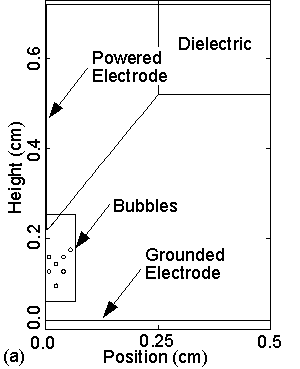
|
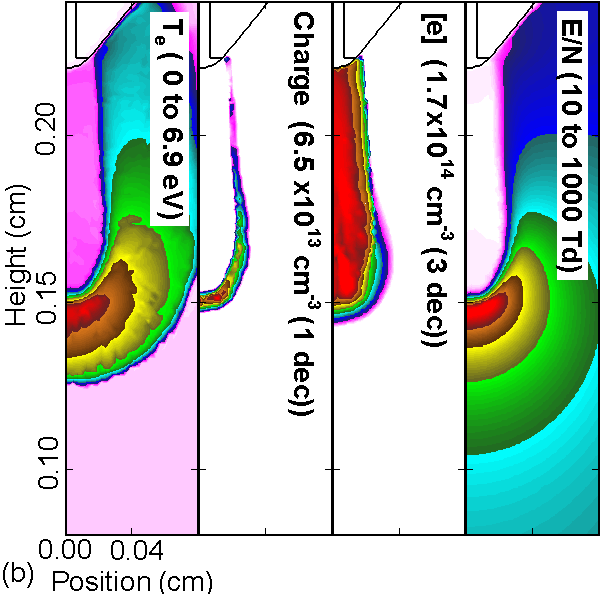
|
| Fig. 1: Streamer corona discharge. (a) Schematic of the computational domain and (b) plasma parameters for a streamer propagating in unperturbed air at 6 ns after the start of 15 kV pulse (electron temperature Te, positive space charge, electron density and E/N). |
3. Branching of streamers on particles and bubbles
The intersection of a streamer with an inhomogeneity can significantly alter its path and properties and produce branching. Solid bubbles (particle) can act as an efficient branching agent due to its resulting polarization. Streamer dynamics with a solid particle with dielectric constant e/e0=2.5 is shown in Fig. 2a. For small a permittivity there is a small enhancement in E/N by polarization fields around the particle. As a result, the avalanche at the bottom of the particle is slow to launch a daughter streamer and the streamer is deflected around the particle before the daughter streamer is launched. High permittivity particles typically launch daughter streamers before branching.

|

|
| Fig. 2: Reduced electric field E/N during streamer branching. (a) Streamer intersects a low permittivity 80 mm solid particle and branches on it. (b) streamer interacts with a rarefied bubble (P/P0=0.92) of 80 mm radius centered 120 mm off axis with subsequent branching. |
When a streamer encounters a lower density bubble, the larger E/N in the bubble produces a higher rate of ionization. A streamer may diverge into a rarefied bubble located off axis due to seeding of electrons in the bubble by photoionization and subsequent avalanching in the large E/N, as shown in Fig. 2b. The pressure difference between the bubble P and the ambient gas P0 to produce this effect can be as small as 7-8%.
4. Streamer branching on highly rarefied bubbles in multi-atmospheric pressure
We investigated the consequences of random inhomogeneities in the form of low pressure bubbles on the propagation and branching of streamers in high pressure humid air. The bubbles have larger E/N than the ambient gas with larger rates of ionization. The large E/N in the bubbles avalanches seed electrons produced by photoionization from the streamer. Each bubble than launches both a negative and positive going daughter streamers that may link with streamers from adjacent bubbles or with the original streamer. The total process than appears as streamer branching. The process does not depend on the polarity of the streamer (with the exception that each bubble launches positive and negative daughter streamers in reverse directions) and weakly depends on the nature of the gas. This is shown in Fig. 3 for a positive streamer in air at a pressure of 3 atm (P/P0=0.065) and for a negative streamer in Ar at a pressure of 7 atm (P/P0=0.028). The ability for bubbles to avalanche depends on the pd product and their placement on a Paschen-like curve for breakdown.
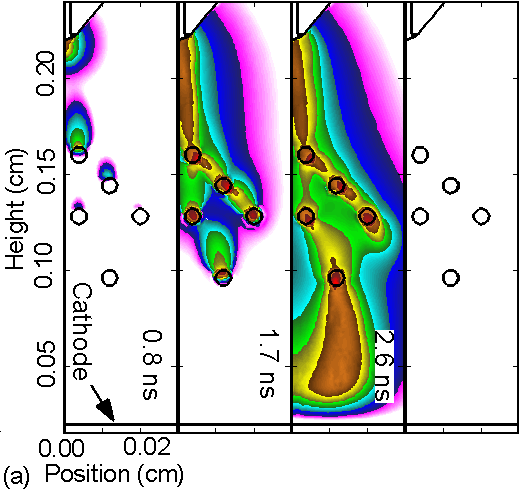
|
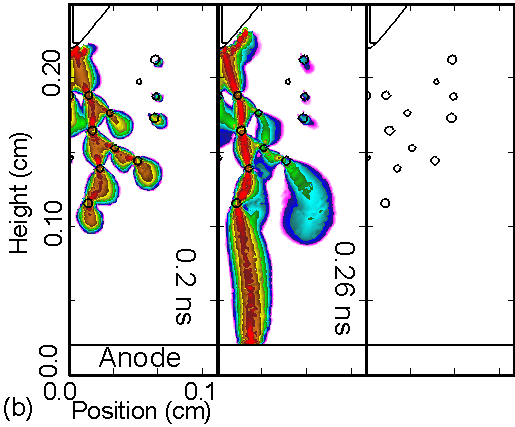
|
| Fig. 3: Streamer branching on multiple bubbles. (a) A positive streamer propagates through 5 randomly placed bubbles of 40 mm radius in an ambient air of 3 atm. The 150 Torr pressure in the bubbles provides a rarefaction of P/P0=0.065. Negative streamers launched by bubbles are directed upward. (b) A negative streamer propagates through 13 randomly placed bubbles of 10 to 30 mm radius in an ambient Ar of 7 atm with P/P0=0.028. Negative streamers launched by bubbles are directed downward. |
4. Structure of positive streamers inside gaseous bubbles immersed in liquids
Streamers often preferentially propagate along the surface of a bubble immersed in a liquid instead of propagating along the axis of the bubble. We placed bubble of humid air (N2/O2/H2O=0.64/0.16/0.2) near the tip of a positively biased electrode immersed in a liquid. For low values of liquid conductivity and permittivity the streamer propagates along the axis of the bubble as shown in Fig. 4a. For large values of conductivity and permittivity the streamer propagates along the surface of the bubble as shown in Fig. 4b.
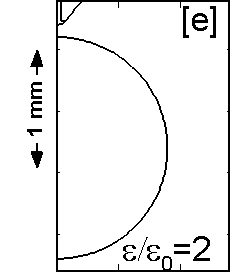
|
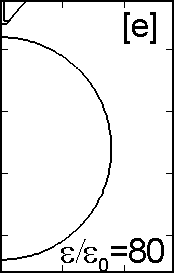
|
| Fig. 4. Electron density inside a bubble 900 mm in radius immersed in a dielectric liquid with (a) e/e0 = 2 and (b) with e/e0= 80. In low e/e0 liquids, the streamer develops as a single filament propagating along the axis. In the high e/e0 liquid, the streamer propagates along the bubble surface. |
For essentially non-conducting liquids, the transition between axial and surface-hugging streamers occurs at 4 < e/e0 < 8, depending on the size of the bubble and voltage (Fig. 5). These trends largely result from the refraction of the electric field by the curved interface of the bubble in the presence of a diverging electric field. The final pattern of the streamer path is additionally a function of bubble size and its position relative to the tip of the electrode, applied voltage and polarity.
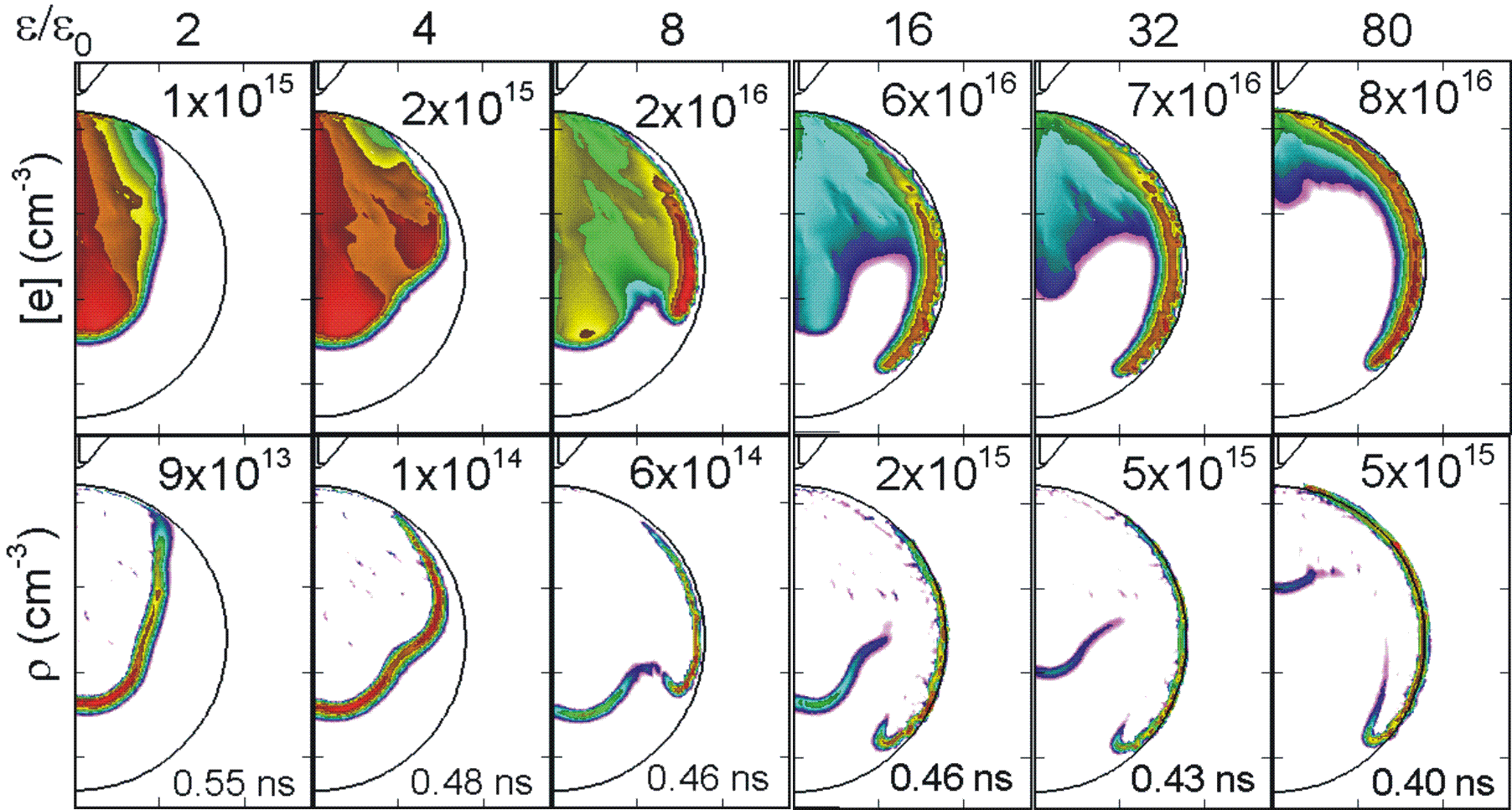
|
| Fig. 5. Electron density and positive charge inside a bubble 900 mm in radius immersed in a dielectric liquid with different e/e0. Typically, two streamers develop inside the bubble – along the axis and along the surface. The final pattern depends on e/e0, with higher values favoring the surface discharge. |
Last updated: June 12, 2009.